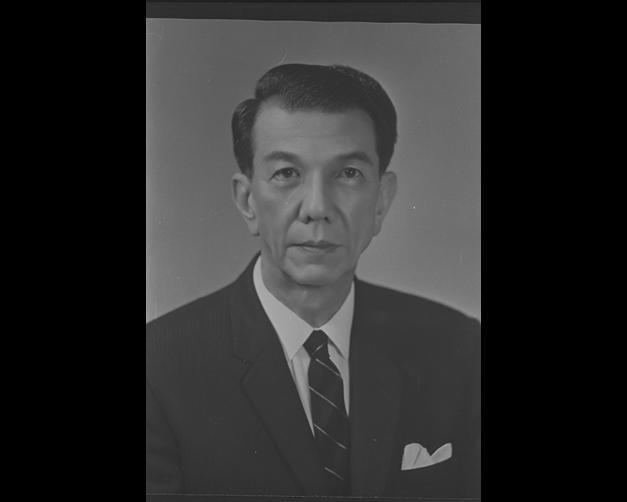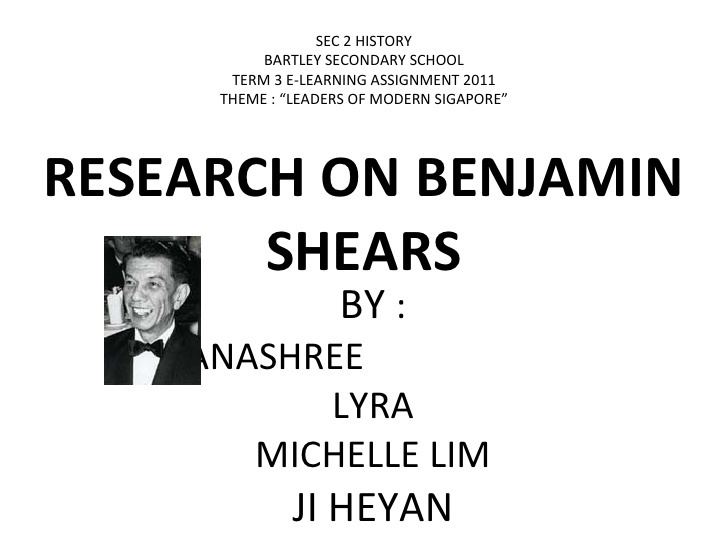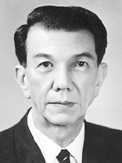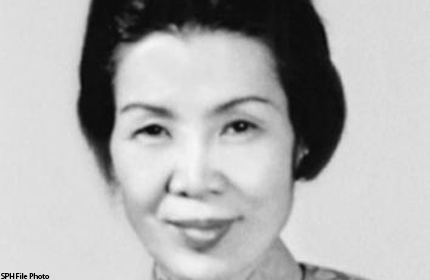Name Benjamin Sheares | Nationality Singaporean Occupation Physician Resigned May 12, 1981 | |
 | ||
Full Name Benjamin Henry Sheares Born 12 August 1907Straits Settlements(now Singapore) ( 1907-08-12 ) Children ConstanceEdwin Chin-HweeJoseph Spouse Yeo Seh Geok Sheares (m. 1939) Education Saint Andrew's School, Singapore Presidential term January 2, 1971 – May 12, 1981 | ||
Benjamin sheares a true pioneer wrong one
Benjamin Henry Sheares (12 August 1907 – 12 May 1981) was a Singaporean politician and professor. He served as the second President of Singapore. Before his presidency, Sheares was a well known and distinguished obstetrician and gynaecologist. He graduated from King Edward VII College of Medicine (now known as National University of Singapore) in 1929 with a medical degree and began his career at the General Hospital (now Singapore General Hospital). During the Japanese Occupation of Singapore, Sheares was the head of the O&G department at Kandang Kerbau Hospital and was appointed acting professor of O&G after the war. He then went for further studies at Royal Postgraduate Medical School in Britain in 1947 and became a full professor in 1950 at the hospital after his return.
Contents
- Benjamin sheares a true pioneer wrong one
- Skull found in benjamin sheares bridge
- Early life and medical career
- King Edward VII College of Medicine and Royal Postgraduate Medical School
- Presidency 19711981
- Notable contributions
- Death and legacy
- References

Sheares retired in 1960 and was in private practice before being elected by parliament as president after President Yusof Ishak died on 23 November 1970. He served as president for three terms from 2 January 1971 until his death on 12 May 1981. The Benjamin Sheares Bridge and Sheares Hall hostel at the National University of Singapore was named after him.

Skull found in benjamin sheares bridge
Early life and medical career

Benjamin Sheares was born the second of six children in Singapore to a Eurasian family with an English lineage. His father Edwin H. Sheares, a technical supervisor of the Public Works Department, was born in England and raised in India. Edwin later migrated to Penang and married Singapore-born Lilian Gómez, of Chinese Singaporean and Spanish descent, and had six children – the first died in infancy. Life was hard for the Sheares family with the meagre salary that Edwin received from his post.

As a young child, Sheares was affectionately known as Ben or Bennie. He was a quiet boy who kept much to himself and loved to play at Peirce Reservoir, where his father worked.
He had a close relationship with his sister Alice and often loved to play doctor with her. On one occasion, he made Alice swallow a one-cent coin as a medical "pill" in their game. Benjamin was six years old then and received a good hiding from his mother Lilian. Throughout his growing years, Benjamin showed ambition to become a doctor – a dream deemed almost impossible for someone who was Asian and came from a poor family in the early colonial days of Singapore. However, Alice continued to spirit him on with that dream, against his mother's wishes for her son to take up a job as a clerk and start helping out with the family bills as soon as he completed his Senior Cambridge Examinations (O-Level equivalent).
King Edward VII College of Medicine and Royal Postgraduate Medical School
Sheares attended the Hwa Chong Institution and then in 1918 went to Saint Andrew's School, Singapore. In 1922, he transferred himself to study at the Raffles Institution, the only school equipped with scientific laboratories – making it an ideal place to further his ambition to become a doctor. In 1923, he enrolled into the King Edward VII College of Medicine (a predecessor of the National University of Singapore) to begin his medical training. Sheares was aware that his family could not see him through the hefty school fees afforded by the College, therefore he won a generous scholarship offered by the Council of the Medical College with his exemplary academic performance. With this quantum, he was able to give $50 monthly to his mother for the support of his family.
He continued to excel in his studies and was awarded four medals by his College. Later, he passed his Obstetrics and Gynaecology (O&G) final examinations with distinctions. Upon graduation and working as an obstetrician in the Kandang Kerbau Hospital and a professor at the University of Malaya he continued to support his family, and assumed full responsibility for his family when his father died in 1940. Sheares was awarded the Queen’s Fellowship which would grant him a two-year postgraduate training in Britain. However, his studies were postponed due to the Second World War. During the war in 1941, the hospital Sheares was working at was damaged by the bombing from the Japanese military and it was converted into a general hospital for injured civilians.
After the war, Sheares was appointed acting professor of O&G at the hospital, which he held on until he went for his postgraduate studies at the Royal Postgraduate Medical School in 1947. He returned to Singapore in 1948 and returned to his post as acting professor of O&G at Kandang Kerbau Hospital before he became a full professor in 1950. Sheares then retired from the hospital in 1960 and went into private practice until he was elected president. He became Honorary Consultant after his retirement and continued teaching both undergraduate and postgraduate students at the hospital.
Presidency (1971–1981)
Benjamin Sheares became Singapore's second president on 2 January 1971. His mother was 91 years of age when she learnt that he had become President of the Republic of Singapore. Just two weeks before she died, she said "God has blessed Bennie especially after the way he looked after us and me." According to a medical assistant of his, Sheares had possibly donated his entire salary as President to charity.
Sheares had served three terms as president from 2 January 1971 until 12 May 1981. He originally wanted to retire after finishing his second term as he felt that he did not have the energy for another term, but then Prime Minister Lee Kuan Yew persuaded him and Sheares aged 70 then, took on his third term as president. Sheares held the office until his death in 1981. C. V. Devan Nair succeeded him as President.
Notable contributions
During his time as head of O&G at Kandang Kerbau Hospital during the Japanese Occupation, Sheares pioneered the lower Caesarian section which resulted in a lower mortality and morbidity rate in pregnant women than the upper Caesarian section. The method is currently the most common Caesarian section method used today. Another one of Sheares' main contributions to medicine was a technique to create an artificial vagina for those born without one. A modification of it is still used for sex change operations today.
Death and legacy
Sheares was found to have tumors in his lung in November 1980 while serving his third term as president. He slipped into a coma on 3 May 1981 and died nine days later on 12 May 1981. Sheares was buried in the Kranji State Cemetery. The Benjamin Sheares Bridge and Sheares Avenue is named after him. In academia, the student's residence Sheares Hall in the National University of Singapore, the Benjamin Sheares Professorship, and the Benjamin Sheares College at the Duke-NUS Graduate Medical School are all named after him.
